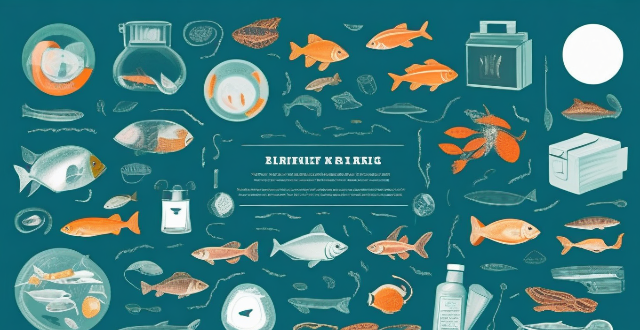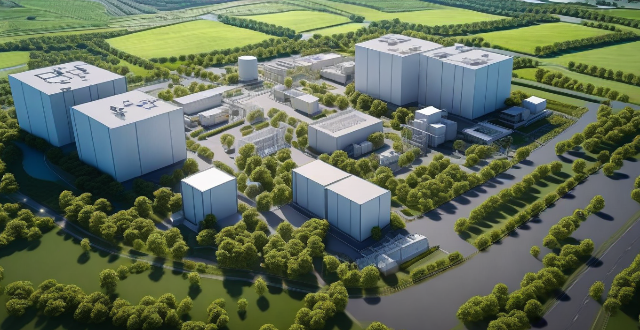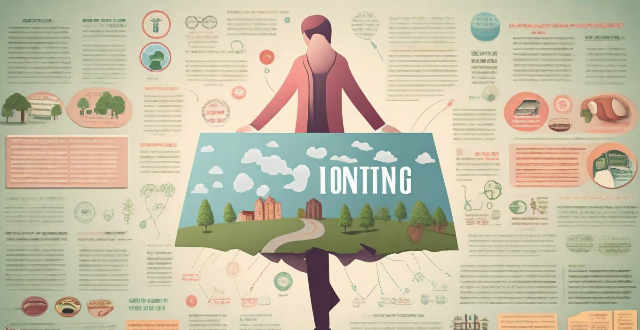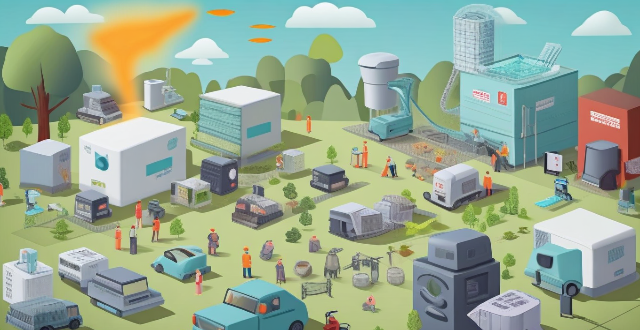Pollution Acidification

What is the impact of greenhouse gas emissions on the environment ?
The impact of greenhouse gas emissions on the environment includes climate change, air pollution, and ocean acidification. Climate change leads to rising temperatures, melting ice caps, and extreme weather events. Air pollution causes respiratory and cardiovascular diseases, while ocean acidification harms coral reefs and disrupts marine ecosystems. Reducing reliance on fossil fuels is crucial to mitigate these effects.

How do greenhouse gas emissions contribute to ocean acidification ?
The article discusses the role of greenhouse gas emissions, particularly carbon dioxide (CO2), in causing ocean acidification. It explains how CO2 gets absorbed by seawater through a process called "carbon sequestration," which leads to changes in the chemistry of the ocean's surface waters and results in decreased pH levels. The article also highlights the negative impacts of ocean acidification on marine ecosystems, including damage to calcifying organisms and disruption of food webs. To mitigate these effects, it suggests reducing greenhouse gas emissions through various means such as transitioning to renewable energy sources, improving energy efficiency, promoting sustainable land use practices, and implementing carbon capture and storage technologies.

How is ocean acidification due to carbon dioxide absorption affecting the health of fish stocks ?
**Ocean Acidification and Its Impact on Fish Stocks** The absorption of carbon dioxide (CO2) from the atmosphere into the ocean causes ocean acidification, leading to a decrease in pH levels and increased acidity. This phenomenon poses significant threats to marine life, particularly fish stocks, through various effects: 1. **Changes in Calcium Carbonate Availability:** As the ocean becomes more acidic, there is less calcium carbonate available for shell formation in many fish species, affecting their growth and survival, especially during early developmental stages. 2. **Altered Food Web Dynamics:** Acidification can cause changes in plankton communities, disrupting the food chain and affecting predator-prey relationships, potentially leading to overpredation or starvation among certain fish species. 3. **Behavioral Changes:** Increased acidity can interfere with sensory systems in fish, affecting their ability to find food, avoid predators, and navigate. It may also alter reproductive behavior, leading to reduced breeding success. 4. **Energy Allocation:** Acidification increases metabolic costs associated with maintaining physiological functions, reducing resources available for growth, reproduction, and other essential processes. It can also weaken the immune system, making fish more susceptible to diseases and parasites. Understanding these effects is crucial for developing strategies to mitigate the impacts of ocean acidification and protect marine ecosystems.

How can governments implement policies to reduce plastic waste and pollution ?
Governments can implement policies to reduce plastic waste and pollution by banning single-use plastics, promoting recycling and composting programs, encouraging sustainable packaging practices, educating the public about plastic pollution, and collaborating with other countries and international organizations.

What are some innovative solutions for controlling plastic pollution in developing countries ?
The text discusses innovative solutions for controlling plastic pollution in developing countries, including promoting recycling and waste management, encouraging alternative packaging materials, educating the public on plastic pollution, implementing bans on single-use plastics, and investing in research and development.

How does plastic pollution impact marine life and ecosystems ?
The text discusses the impact of plastic pollution on marine life and ecosystems, including entanglement and ingestion by animals, chemical pollution from toxic additives, habitat destruction, food chain disruption, economic impacts on tourism and fishing industries, aesthetic and cultural impacts on coastlines and ocean environments, and solutions and mitigation efforts such as reducing plastic use, improving waste management, cleanup campaigns, education and awareness, policy changes, and research and innovation.

How do ocean acidification and warming impact marine biodiversity ?
Marine biodiversity is threatened by ocean acidification and warming, which can have significant impacts on the ocean's ecosystems. Ocean acidification reduces the availability of carbonate ions, making it harder for calcifying organisms to build their shells or skeletons, leading to weaker structures or death. It also changes food webs as key species become less available as a food source. Ocean warming causes changes in species distribution and potential new interactions between species that did not previously overlap. Coral bleaching events occur when waters become too warm, making corals more susceptible to disease and potentially causing them to die off. Warmer waters can also lead to the loss of important habitats for certain species like polar bears. Taking action to reduce greenhouse gas emissions and protect the ocean's delicate balance is essential to preserve marine biodiversity for future generations.

Do hybrid cars produce less pollution than traditional gasoline cars ?
Hybrid cars generally produce less pollution than traditional gasoline cars, but the comparison is not straightforward and various factors must be taken into account.

How do clean production technologies help reduce waste and pollution ?
Clean production technologies are vital in reducing waste and pollution. They achieve this through energy efficiency, resource efficiency, improved waste management, pollution control, and a holistic approach to sustainability via life cycle assessment. By implementing these technologies, industries can operate in a more sustainable manner, minimizing their environmental impact.

How does air pollution caused by climate change affect children ?
The provided text discusses the impact of air pollution, exacerbated by climate change, on children's health. It outlines both immediate and long-term health effects, including respiratory issues, developmental concerns, chronic conditions, and potential for other health problems. The text also highlights the socio-economic impact of these health issues, such as school performance and healthcare costs. Prevention and mitigation strategies are suggested, including reducing pollution sources, promoting clean energy, awareness and education, and urban planning. The conclusion emphasizes the need for collective action to protect children's health and future.

What are the long-term effects of air pollution on our health ?
The long-term effects of air pollution on health are wide-ranging and severe, affecting individuals and entire communities. Respiratory diseases, cardiovascular diseases, neurological disorders, reproductive health problems, and other health issues have all been linked to exposure to polluted air. It is essential to address air pollution as a public health issue to protect the health and well-being of people worldwide.

What are the most effective ways to control plastic pollution ?
The text discusses the issue of plastic pollution and its harmful effects on the environment and human health. It provides various methods to control this problem, including reducing plastic use, recycling properly, supporting eco-friendly brands, implementing government policies such as banning single-use plastics, promoting recycling infrastructure, and investing in research and development for sustainable alternatives to plastic. The text emphasizes that controlling plastic pollution requires collective efforts from individuals, businesses, and governments to achieve a cleaner and healthier environment for all living beings on Earth.

What is the role of businesses in controlling plastic pollution ?
Businesses have a crucial role in controlling plastic pollution. They can reduce plastic production by switching to biodegradable materials and improving recycling efficiency. Promoting sustainable practices, such as encouraging consumer responsibility and partnering with environmental organizations, is also essential. Investing in research and development for alternative products and improved recycling technologies further helps control plastic pollution. Businesses that prioritize sustainability will likely see long-term benefits in profitability and reputation.

What are the challenges faced by recycling facilities in controlling plastic pollution ?
Recycling facilities face numerous challenges in controlling plastic pollution, including logistical issues in collection and sorting, technological and economic constraints in processing, environmental concerns, and the need for public education. Addressing these challenges requires collaborative efforts from governments, industries, and individuals committed to reducing plastic pollution through effective recycling strategies.

How does proper waste management aid in saving energy and reducing pollution ?
Proper waste management is crucial for conserving energy and reducing pollution. It involves strategies like composting organic waste to reduce methane emissions, enhancing recycling to save energy in manufacturing new products, preventing environmental pollution through proper disposal, promoting sustainable practices like reduce, reuse, and recycle, and supporting the circular economy model. By adopting these measures, we can move towards a more sustainable future that conserves resources and protects our planet.

What impact does air pollution have on indoor sports facilities and athletes' health ?
Impact of Air Pollution on Indoor Sports Facilities and Athletes' Health: - **On Indoor Sports Facilities**: - Reduced visibility, unpleasant odors and tastes, equipment damage, and increased energy consumption due to air pollutants. - **On Athletes' Health**: - Respiratory problems, cardiovascular disease, asthma attacks, skin irritation, fatigue and lethargy, cognitive impairment, and immune system suppression due to exposure to air pollutants.

How can individuals contribute to reducing plastic pollution in their daily lives ?
Reducing plastic pollution requires individual effort and collective action. Here are key steps to minimize your plastic footprint: 1. **Bring Your Own Reusable Bags**: Avoid single-use plastic bags by carrying reusable shopping bags made from durable materials. 2. **Use Refillable Water Bottles**: Invest in a high-quality, BPA-free refillable water bottle to avoid buying bottled water. 3. **Say No to Single-Use Plastic Utensils**: Carry reusable utensils made from eco-friendly materials like bamboo or stainless steel. 4. **Opt for Bulk Foods**: Choose loose fruits and vegetables over pre-packaged ones and use reusable containers for bulk items. 5. **Choose Products with Less Packaging**: Opt for products with minimal or recyclable packaging and support eco-friendly brands. 6. **Recycle Properly**: Familiarize yourself with local recycling guidelines and ensure items are clean and sorted properly. 7. **Participate in Cleanup Events**: Join community efforts to remove plastic waste from the environment and raise awareness. 8. **Educate Others**: Share knowledge about plastic pollution and encourage others to adopt habits that reduce plastic use. 9. **Support Legislation and Policies**: Advocate for policies that reduce single-use plastics and promote recycling initiatives. By making these changes, individuals can contribute significantly to reducing plastic pollution and protecting the environment.

What are the consequences of not having adequate environmental legislation ?
The text discusses the importance of adequate environmental legislation and its absence's consequences. It outlines the impact on environmental degradation, human health, economic stability, and social welfare. The introduction emphasizes the need for such laws for sustainable development and planet protection. Four main points are discussed: 1. Environmental Degradation includes loss of biodiversity, pollution, deforestation, and ocean acidification. 2. Human Health Impacts cover respiratory problems, waterborne diseases, and food safety concerns. 3. Economic Implications involve resource depletion, job losses, and tourism decline. 4. Social Welfare Issues include inequality, displacement, and conflict over resources. The conclusion stresses the urgency for governments worldwide to implement and enforce strong environmental laws for a sustainable future.

How does environmental degradation affect global ecosystems ?
Environmental degradation affects global ecosystems in various ways, including loss of biodiversity, disruption of ecosystem services, changes in the carbon cycle, and impact on human health. It is crucial to take steps to mitigate environmental degradation and protect our planet's ecosystems for future generations.

Can environmental legislation effectively reduce pollution ?
Environmental legislation has the potential to effectively reduce pollution, but its success depends on various factors such as enforcement and compliance, public awareness and participation, technological innovation, political will, international cooperation, and economic considerations. Strong regulatory bodies, education campaigns, investment in clean technology, government prioritization of environmental protection, global collaboration, and balancing environmental goals with economic development are all crucial for the effectiveness of environmental legislation. Achieving lasting improvements in environmental quality requires ongoing effort from all sectors of society.

How does air pollution affect the environment ?
The text discusses the impact of air pollution on the environment and outlines strategies to mitigate its effects. It highlights how air pollution contributes to climate change through greenhouse gas emissions and ozone depletion, degrades ecosystems through acid rain and habitat loss, affects human health by causing respiratory and cardiovascular diseases, reduces visibility with smog and haze, and leads to economic consequences such as crop damage, increased healthcare costs, and a decline in tourism. Mitigation strategies include transitioning to renewable energy sources, promoting efficient transportation, enforcing industrial regulations, implementing urban planning, and cooperating through international agreements.

Can green packaging reduce waste and pollution ?
Green packaging aims to reduce environmental impact by using sustainable materials. It can decrease landfill waste, energy consumption, and pollution but faces challenges like cost, durability, and recycling infrastructure. To maximize its benefits, companies should research eco-friendly materials, design recyclable packages, educate consumers, collaborate with stakeholders, and continuously monitor their practices.